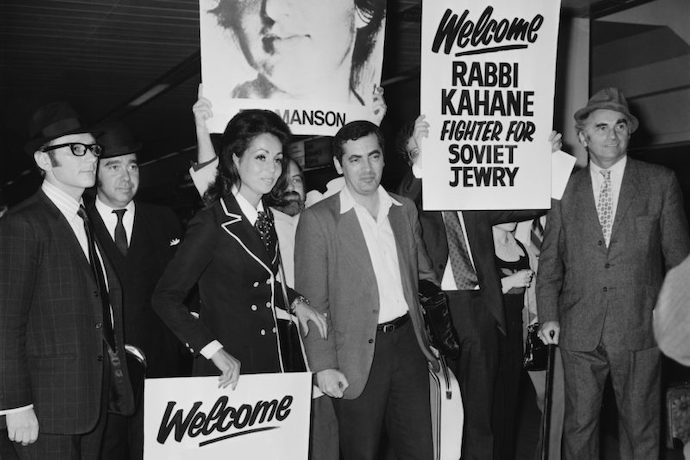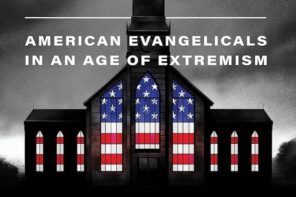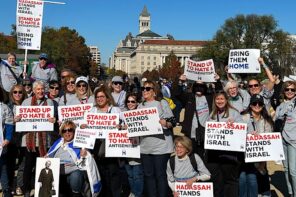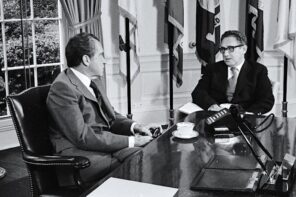There is an old Hungarian Jewish proverb that says, “antisemitism is when gentiles hate Jews too much.” The underlying assumption, of course, is that the gentile always hates the Jew; antisemitism* is only when that hatred becomes overt. Most American Jews today may not quite believe that, but the assumption surfaces again when cases of Jew-hatred arise—and especially in the weaponizing of accusations of antisemitism.
In a piercing essay on the categorical confusion surrounding the term, “Away from a Definition of antisemitism,” David Engel, Maurice Greenberg Professor of Holocaust Studies at NYU, traces the way that it originated in the mid-19th century as a label for a very local and limited position among a group of anti-emancipation Germans who held that the rights granted Jews were threatening to the vitality of the German Republic. It was not, Engel argues, a term describing the secularized extension of medieval Christian anti-Judaism. Nor was it used to connote any broad accusation against the Jews.
But the term soon took on such baggage. In 1892 an editorial in the Allgemeine Zeitung des Judenthums, likely written by its editor Ludwig Philippson, argued for “an essence” of antisemitism, “a timeless spirit possessing an essence that was a permanent feature of human social behavior, imply[ing] that the spirit could exist independently of what any particular ‘antisemite’ said or did.” With such an assessment, a sharp definition of the term becomes unnecessary. If we assume that antisemitism is “timeless” and “permanent,” it becomes simply whatever one says it is, because, in effect, it is everywhere. Engel himself rejects this essentializing. Yet he shows its lasting consequences: “In the end, it seems, ‘antisemitism’ is indeed an invented analytical category, not a discovered one. As such, its boundaries are arbitrary; no statement about what ‘antisemitism’ is or is not can compel acceptance except by social agreement.”
What is antisemitism, and who is an antisemite? The issue has become important, yet again, because the upcoming Women’s March has been derailed due precisely to this very conundrum. The controversy centers around a figure, Louis Farrakhan, who as leader of the Nation of Islam (NOI) has repeatedly and overtly espoused views of Jew-hatred that one could unequivocally call antisemitic. But he’s not really the issue, since he has nothing to do with the Women’s March. Rather, the question of antisemitism, and its definition, has to do with two prominent organizers, Linda Sarsour and Tamika Mallory.
Sarsour is known in the Jewish community as a prominent American Muslim activist who supports BDS (Boycott, Divestment, and Sanctions) and openly criticizes Israeli oppression of Palestinians. As a Palestinian whose family has lived under a half-century of Israeli occupation, she has also criticized progressive Jews who continue to support Israel, questioning their progressive credentials.
Although she’s a Christian, Tamika Mallory has openly posed with Farrakhan and spoken about the positive work he’s done in the Black community, including in prisons and in crime-ridden neighborhoods. Many in the Jewish community have deemed both Sarsour and Mallory antisemites because of their views on Israel but also because of their unwillingness to totally repudiate Farrakhan. Mallory’s Instagram post with Farrakhan from 2017 has frequently been singled out to show how closely entwined the two seem to be:
https://www.instagram.com/p/BT9wDcUBShs/
In response, Sarsour and Mallory have repudiated Farrakhan’s antisemitic statements, and Sarsour, in particular, has written an apology to the Jewish community. But since they haven’t repudiated Farrakhan as a figure, accusations of antisemitism remain.
The reaction is an example of what Engel notes about antisemitism. Sarsour, for instance, raised tens of thousands of dollars in her Muslim community to repair the desecrated cemetery in St. Louis after an antisemitic attack, using some of the extra funds to repair a Jewish cemetery in Colorado. She also raised tens of thousands of dollars to pay for the funerals of the 11 Jews massacred in Pittsburgh (the American Muslim community was one of the first to donate money to the Jewish community in Pittsburgh).
But these gestures and her apology were largely not accepted by the Jewish community; once someone is given the label antisemite, anything that person does is considered bad faith. This is because antisemitism is no longer a consequence of actions or behavior, but some kind of embodied hatred that cannot be erased or undone: it is the exposure of a “permanent feature” that is assumed to be timeless, essential, and thus inevitable.
And, instead of a definition, as Engel argued, it’s simply what’s determined by “social agreement”; and today the social agreement seems to be that BDS or anti-Israelism is antisemitism. Showing solidarity with Jews in America, or donating money to help a community after an antisemitic act, is thus interpreted as if it is by definition insincere at best, trickery at worst. Acknowledging the good the NOI has done in helping single Black women and incarcerated Black men doesn’t matter because acknowledging the legitimacy of an antisemite, even regarding things that have nothing whatsoever to do with Jews, puts one in his camp. Antisemitism is no longer a descriptor of behavior, but a tool of exclusion.
This controversy, in short, is an example of how antisemitism has become weaponized. One can no longer be wrong when it comes to Israel and the Jews without the possibility of being called an antisemite or self-hating Jew. And once that happens, that’s all you are. I personally think Sarsour is wrong about some of the things she says about American Jews and Israel. Accusing someone of being mistaken invites conversation and exchange.
But the label antisemite makes such engagement forbidden, or at least futile, because it’s not an error in judgment but a state of being. You cannot repudiate an antisemite’s antisemitism and still hold that s/he has done good things for another community, because antisemitism permeates her/his entire being: They embody something that is beyond them and permeates everything they say or do. It becomes their essence. It’s only by such logic that it makes sense to extend the label of antisemite, not just to those with explicit Jew-hatred, but also to those who refuse to totally disassociate with them.
There’s a pretty clear consensus that Farrakhan is an antisemite (even Sarsour and Mallory have acknowledged the repugnancy of his remarks), but why should this then extend to anyone who supports other things he’s done? What all this shows is that many are stuck in the crevasse between an essentializing of antisemitism and the arbitrariness of defining what that essence is.
For some, this extends to those who have any relationship with an antisemite; to those who offer a deep critique of Israel as a legitimate state as presently construed; or to anyone who supports a nonviolent action to pressure Israel to end the occupation. Let us not forget, however, that the state of Israel did not officially recognize the valid existence of the Palestinian people until the early 1980s, and that there are many Jews today—some members of the Israeli Parliament—who still do not recognize the legitimacy of a Palestinian people with rights of self-determination. How different is that from claims that the Jews don’t have a right to their own state?
II
Jews, of course, like many communities, have—and have had—their own Farrakhans. And many Jews certainly have not treated them, related to them, or engaged with them as they expect American Muslims and African Americans to now treat Farrakhan. I think the best example of a “Jewish” Farrakhan is Rabbi Meir Kahane. It is said, in fact, that Kahane was once asked in a radio interview in the 1970s, “What is the difference between you and Farrakhan?” To which Kahane allegedly replied, “The only difference between us is that I am right!”
A militant American rabbi, Kahane founded the Jewish Defense League (JDL) in 1968 in response to the Black antisemitism that arose in the aftermath of the 1968 Ocean Hill-Brownsville NYC school strike. That conflict, which led to a citywide strike, pitted a Jewish leader of the United Federation of Teachers, Albert Shanker, against Black parents of school children and community leaders such as Rhody McCoy and black panther Stokely Carmichael.
The JDL’s initial mandate was to provide civil patrols, in what were then called “frontier neighborhoods,” to protect elderly Jews from racial violence. Branches of the JDL soon opened in New York City, Boston, Philadelphia, Cleveland, Chicago, and many other cities. Kahane himself espoused explicitly racist views of African Americans. Of course, he denied he was a racist—as most racists do—even publishing an essay in 1987 in The Jewish Press, a Brooklyn-based weekly he edited, entitled “I Hate Racism.”
By the early 1970s, Kahane and the JDL became embroiled in arms-smuggling and other illegal activities for which Kahane was found guilty and given a five-year suspended sentence. Kahane immigrated to Israel in 1971 but returned to the United States often, becoming a leading figure in the Movement for Soviet Jewry. After numerous parole violations, Kahane was sentenced in 1975 to serve a year in the Allenwood prison before returning to Israel to launch his political career.
Founding his own party, he was elected to the Israeli Parliament in 1984, and in 1987 the Parliament passed a “Racism Law” (written specifically for him and his party), which resulted in his removal from the Parliament and marked the end of his political career. But he continued speaking, writing, and touring in Israel and in American synagogues and universities until he was assassinated in New York in November 1991.
I offer this very brief synopsis to suggest that Kahane was arguably more volatile, and certainly wreaked more havoc, than Farrakhan. Yet, like Farrakhan, Kahane’s racism was mixed with intense devotion to his community and he had a positive influence on many young Jews who felt Judaism and Jewish identity had no meaning, some of whom had fled the New Left after it turned anti-Israel around 1967. Kahane successfully instilled a sense of pride, what he called “Hadar” (borrowing the term from Zionist Revisionist Ze’ev Jabotinsky), in the hearts of many young alienated Jews.
One might think that given Kahane’s antics—given his anti-Black and later anti-Arab rhetoric, as well as his advocacy of violence—that he would be a persona non grata for most of the Jewish community. One might expect that identifying with him, defending him, or even giving him a voice would be unacceptable. and that those who would do so would be alienated from the community. But this would be an error. Through much of the late 1960s and 1970s, many prominent and mainstream Jews repudiated Kahane’s racism and use of violence, but they nonetheless defended his right to speak and be part of the Jewish conversation. In a 1971 Look Magazine poll, moreover, one in four American Jews polled had a “positive attitude” about the JDL.
In the late 1960s there was a push in The Young Israel of Brookline congregation to open a JDL chapter. Its young rabbi, Saul Berman, who a few years before had been in the South fighting for civil rights, didn’t agree with Kahane’s views or tactics, but he did agree to open a JDL chapter in his synagogue. At that time, the JDL established civil patrols, many in conjunction with the Boston Police Department, to police the largely Black and Jewish neighborhoods of Dorchester and Mattapan. Jews, especially elderly Jews, were in danger. The JDL established these patrols to ensure the safety of the Jews in those neighborhoods.
As a rabbi in Boston, Berman was certainly aware of the dangers Jews faced at the time and assumed the JDL would help. In addition, prominent rabbis such as Emanuel Rackman, president of the New York Board of Rabbis and the Orthodox Rabbinical Council of America (and later rector of Bar-Ilan University in Israel) supported Kahane and the JDL in its early years, although he later turned strongly against him, as did many other rabbis.
In 1971, Kahane attended the Brussels conference on Soviet Jewry uninvited and was denied the right to speak by the organizers. He was arrested by Belgian police and sent back to America. The international conference was held in the Palais des Congres in Brussels and was intended to give public voice to the plight of Soviet Jewry. Menachem Begin, soon to be Prime Minister of Israel, was the only one in the closed session who voted in favor of allowing Kahane to speak, accusing the organizers of an “un-Jewish act” in turning him over to the police.
After Kahane was arrested, Otto Preminger, in his public address that evening to the delegates, said Kahane was treated “exactly as contemptible and wrong as what the Nazis and the Soviet Communists have done.” Reflecting on the event, Kahane wrote in 1975, “Brussels, where dissent was stifled, where fearful men kept out Jewish militancy, where a Jew was seized by Belgian police and expelled by force with the knowledge and approval of Jews. This was the story of Brussels. And more, it was the story of the Jewish establishment and why JDL came into being.”
A little after 9 a.m. on January 27, 1972, a bomb went off in the offices of Sol Hurok Enterprises, causing a fire that injured 13 employees and killed a 27-year-old employee, Iris Kones, from smoke inhalation. Hurok was an impresario who often booked Russian acts to perform in America. The bombing, widely believed to be the work of the JDL, resulted in many of those who disagreed with Kahane, but who defended his right to speak, distancing themselves from Kahane and the JDL. It was in many ways, his “Waterloo.” But he still retained some support, even among those who disagreed with him. Three years later, at a second Brussels Soviet Jewry conference in 1976, Kahane wanted to speak and again was denied. This time, in addition to a petition signed by prominent rabbis and Jewish leaders, New York’s Jewish Week and the B’nai Brith Messenger defended Kahane’s right to speak.
On November 5, 1990, Kahane was murdered in New York City after giving a speech at the Marriott Hotel on Lexington Avenue. The funeral was enormous and numerous prominent rabbis spoke, many of whom vehemently disagreed with him. Rabbi Morris Schmidman said in his eulogy, “This shot was fired at all Jews.” Rabbi Marc Angel, president of the Rabbinical Council of America said that, “The assassin in the minds of many will have justified Kahane’s ideology.”
Rabbi Moshe Tendler, a prominent rabbi and professor at Yeshiva University mocked “Jewish assimilationists” who failed to heed Rabbi Kahane’s call, saying God spoke to Kahane clearly, but many did not heed his “prophecy.” The celebrated musician of postwar America, Rabbi Shlomo Carlebach, also gave an impassioned eulogy. Not one of these rabbis was ostracized or marginalized for their support of Kahane, and many still hold prominent positions in the Jewish community to this day.
My point here is not to weigh in on the Kahane episode as much as to point out that in regard to Kahane, even after the Hurok bombing; even after he was a convicted felon and served time in prison; even as most Jews rejected Kahane’s racism and advocacy of violence; many prominent Jews defended his right to speak. They did so in part because they understood that Kahane was more than a racist and a militant. He also sought to protect Jews and to instill pride in many who were alienated from Judaism or the Jewish community. In the case of Farrakhan, it’s not about allowing Farrakhan to speak at the Women’s March; that would surely be unacceptable. The question is whether it’s reasonable to demand that its organizers totally repudiate him—not just his antisemitism, which they already have—before being considered legitimate in the eyes of most American Jews.
III
There is a long discussion in the Talmud tractate Avodah Zara about the prohibitions regarding idols and idolatry. The idol itself, the Talmud teaches, is something that Jews are prohibited from worshiping, owning, manufacturing, and even benefiting from in any way. There is then a secondary set of objects that may be used to adorn an idol but are not the idol itself. These objects are still prohibited, but the prohibitions are not as strict. There is then a tertiary category called “afar d’avodah zara,” literally “dust of idolatry,” that includes objects even further removed from the idol and its worship. An example the Talmud brings is a broom that’s used to sweep up around the idol but has no contact with it nor is it present as the idol is worshipped. This object has even fewer prohibitions and is, in many cases, permitted.
It seems that, regarding antisemitism, at least in light of Farrakhan and the Women’s March, there are no gradations similar to the Talmud’s discussion of idols. One who is deemed an antisemite must be contested and avoided at all costs. This is in accord with the Talmud’s logic. And even one who has a secondary relationship to that person—even one who openly repudiates his antisemitic speech but acknowledges the work he has done elsewhere—is still delegitimized until they repudiate the person totally and unequivocally. It would be nice for Mallory to have repudiated Farrakhan more fully but the fact that she and Sarsour unequivocally repudiated his antisemitism yet acknowledged the good he has done does not make them antisemites by association. It is, on the one hand, surprising that we seem to have a stricter view of antisemitism than the rabbis had of idolatry and yet, given Engel’s argument that the essentializing of antisemitism easily leads to thinking it is everywhere, even when unseen, and even when repudiated, makes this unfortunate reality all too predictable.
Jews have every right to be wary of antisemitism wherever it shows its face. And they have every right to call out antisemitism whenever it emerges. The Women’s March organizers have done so in regard to Farrakhan. But going further and demanding that anyone who espouses ideas that are abhorrent and unacceptable—even if they also have done some important things for one’s community—must be totally rejected and repudiated, this is a political positionality that many Jews themselves did not assume when it came to Kahane.
Even after Kahane was removed from the Israeli Parliament and deemed a “racist” by the Jewish state, he was invited to speak at Yeshiva University as recently as 1988. And he spoke at Brandeis University in 1990, where I was then a graduate student, only a few days before he was assassinated. I do not criticize those who defended Kahane’s right to speak while openly disagreeing with his views. In fact, I understand them. Figures like Kahane and Farrakhan are complex. And the intentions of those who acknowledge their contribution even as they detest some of their views is understandable, even as I may disagree with them. I do not think those who signed the petition defending Kahane’s right to speak in Brussels in 1975 should be marginalized from the Jewish community. And I don’t think Sarsour and Mallory should be viewed as antisemites by association.
I think Kahane was a racist and I think Farrakhan is a racist. But if we make the case that Kahane and Farrakhan should have no role whatsoever in rational discourse—if we require total repudiation of both as a litmus test for legitimacy—that is, in my view, an unhealthy sign.
The accusation of antisemitism in regards to Sarsour, because of her views on Israel, speaks to a weaponizing of the term that is in part a product of a traumatized community that cannot extricate itself from the belief encapsulated by the proverb I cited at the outset—that is, that everyone really hates the Jews. It may be true in certain cases, but to interpret all cases of accusations against Jews and/or Israel as expressions of a single antisemitism is nonetheless misleading, as Engel shows. In regard to Mallory and her ties to Farrakhan, I would suggest that Jews ourselves have not met that standard of proof. Farrakhan is no worse than Kahane in terms of his vitriol, his hatred, and his bigotry. Kahane all but acknowledged that when he said the only difference between them was who was right.
Some have now asked both Sarsour and Mallory to step down because of the toxicity of the controversy, which is probably a good idea, regardless of whether they are guilty of the accusations made by many in the Jewish community. I personally do not think the vitriol against them was warranted. But the toxicity that emerged in light of these questions has unfortunately detracted from the important mandate of the march. Beyond that, the larger question remains—about antisemitism, the weaponization of antisemitism, and the dangers of both.
*While RD and Rewire.News adhere to the AP style guide, the writer prefers “antisemitism” and “antisemite” to “anti-Semitism” or “anti-Semite” because the terms are specific to Jews and not to “semites” generally; Jews are not hated because they are “semites” but because they are Jews.





